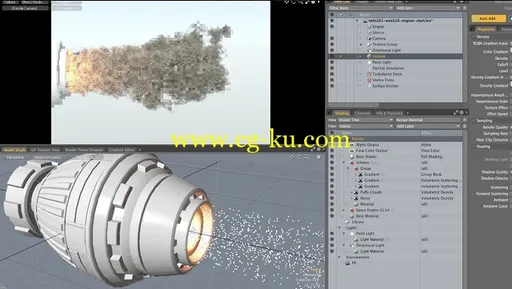
10 Classes Project Files Included MP4
Title: FXPHD – MDO201 MODO 701 Particles, Dynamics & Effects
Info:
At the core of the Modo pipeline resides an extremely powerful dynamic simulation and particle effects engine. In this course, we’ll take an in-depth examination of the moving components of the Modo particle system, hard and soft body dynamics and the rendering pipeline for these exciting effects. The Modo particle system has a strong core of features that will allow us to easily create an array of emitter types, particle modifiers, collision effects, flocking and particle terminators.
In addition to exploring the Modo particle system, prof Pat Crandley will share some invaluable production techniques along the way as we explore scene management, object referencing, the role of the gradient editor and how the new animation workflow can be used to animate, simulate, and render particle effects in Modo.
Pat Crandley has been a 3D modeler, animator and editor in the computer animation and visual effects industry for over 10 years. Crandley served as the Post-Production Supervisor for the 3D Animation department at MTV and oversaw the production of a computer animated series called Video Mods. He also worked as the lead modeler and animator for a series of commercials for Coke, Mike’s Hard Lemonade and Debers Diamonds. He recently finished working at Peppers.TV as the Senior 3D Artist and Technology Geek. Currently, Pat is teaching the next generation of 3D modelers and animators at Sacramento City College and The Art Institute of California: Sacramento.
CLASS 1
This course will begin with an overview of the replicator system. Many of the core components of the particle system stem from Replicators, so we’ll explore the simple, yet powerful, set-up procedures for adding Replicators to our scene. In addition, we’ll also take a look at the animation layout and briefly discuss the process of animating in Modo.
CLASS 2
In order for us to quickly populate our scene with particles, we need to understand the basic simulation system in Modo. We’ll explore the the different simulation types, their features and the best production pipeline for adding simulations in to our scene. Through this process of learning how to generate simulations in Modo, you’ll learn how to simulate rigid body dynamics in Modo.
CLASS 3
Now that we have a basic understanding of how the Modo simulation engine operates, let’s begin to explore the different emitters types in Modo. The array of emitters types will allow us to create a huge spectrum of effects, so lets explore these unique items in Modo. Emitters, Radial, Curve, Surface, Source.
CLASS 4
Collector Emitters are simulations that are based on the result of another simulation. Through the complex network of schematic nodes, we’ll create compound particle effects in Modo. Let’s check it out!
CLASS 5
At times, we want the parameters of our particles to be effected by events within our 3D scene. We’ll look at that role of Terminators and discover how we can filter events within our scene to kill our particles or spawn new particles. Paired with Falloffs, Terminators are an exciting addition to the particle engine in Modo and ultimately allow us to create dynamic particle effects.
CLASS 6
We take a look at how to apply forces within our 3D scene. The Modo particle system allows us to create a series of intricate forces that will influence our particle simulations in some really awesome ways. Let’s check it out! Any force item can be linked to a particle simulation as a filter. Particles will accelerate based on the strength of the force at their location and their mass. These are the same forces used for rigid body dynamics.
CLASS 7
At the core of the Modo particle system resides a powerful engine that allows us to intelligently parse particle simulations on rules, or expressions, within the scene. Adding Particle Modifiers to the schematic layout of our scene can instantly change the complexity, accuracy and creative result of our particle system.
CLASS 8
The Particle Operator is a general filter modifier type item that can be used to process and modify all particles in a simulation based on user selected Features. Let’s take a look at how we can set-up our scene to include this exciting new addition to the Modo particle system.
CLASS 9
We are going to talk about Flock and Dynamic Colliders. Flocking is a particle operator that creates forces between particles that produce distinct particles groups or clumps. The Dynamic Collider has no user adjustable attributes in the Properties panel, it is merely meant as a bridge to share data between a particle simulation and a soft or hard-body dynamics simulation when calculating collisions between them. This allows users to control which simulations are necessary to share data, which can save valuable calculation time for complex simulations of all types. Let’s take a look!
CLASS 10
We wrap up our introduction to the particle system in Modo by
10 类项目文件包括 MP4
标题 ︰ 数码 — — MDO201 MODO 701 颗粒、 动力学及影响
信息 ︰
Modo 的核心管线驻留极为强大的动态模拟和粒子影响发动机。在本课程中,我们将采取 Modo 的粒子系统,硬的运动部件进行深入检查和软体动力学和渲染管线这些令人振奋的效果。Modo 粒子系统具有强大的核心功能,将使我们能够很容易地创建数组的发射器类型,粒子修饰符,碰撞效应,植绒和粒子的终止符。
除了探索 Modo 粒子系统,教授帕特 Crandley 将分享一些宝贵的生产技术沿途为我们探索场景管理,对象引用,渐变编辑器和如何使用新的动画工作流程进行动画处理,角色模拟,和渲染粒子效果在 Modo。
Pat Crandley 10 多年一直 3D 建模师、 动画师和计算机动画和视觉特效工业中的编辑器。Crandley 担任 MTV 3D 动画部后生产主管和监督生产称为视频 Mods 的电脑制作的动画片系列。他还担任铅建模和动画师一系列广告的焦炭,迈克的硬柠檬水和Debers 钻石。他最近完成了在 Peppers.TV 的工作,作为高级 3D 艺术家和技术怪。目前,帕特教学下一代 3D 建模和动画师在萨克拉曼多市大学和加利福尼亚艺术学院 ︰ 沙加缅度。
1 类
本课程将以复制程序系统的概述开始。很多粒子系统的核心组件源于烧录器,所以我们将探索简单,但功能强大,设置程序将复制器添加到我们的场景。此外,我们也看看动画布局再简要地讨论一下在 Modo 进行动画处理的过程。
2 班
为了让我们来快速填充我们与粒子的场景,我们需要了解 Modo 的基本仿真系统。我们将探索不同的模拟类型、 它们的特征和最佳生产管道用于添加到我们的场景中的模拟。通过学习如何在 Modo 生成模拟此过程,您将学习如何模拟 Modo 的刚体动力学。
3 类
现在,我们有一个基本的了解,Modo 仿真引擎的运作,让我们开始探索中 Modo的不同滴头类型。数组的发射器类型将使我们能够创造巨大的光谱的影响,所以,让我们探索中 Modo 这些独特的项目。发射器,径向、 曲线、 曲面、 源。
4 班
收集器发射体是基于另一个仿真结果的模拟。通过示意图节点的复杂网络,我们将在Modo 创建复合粒子效果。让我们试试看 !
第五类
有时,我们希望我们的颗粒,须藉我们 3D 场景中的事件的参数。我们会看看那终结者的角色,并发现如何我们可以在我们的场景来杀死我们的颗粒或产生新的粒子内筛选事件。搭配 Falloffs,终结器是令人兴奋的除了 Modo 中的粒子引擎和最终使我们能够创建动态粒子效果。
6 班
我们看看如何应用在我们的 3D 场景中的部队。Modo 粒子系统允许我们创建一系列错综复杂的力量,将会影响我们的粒子模拟在某种程度上真的很棒。让我们试试看!任何力量项目可以链接到作为筛选器的粒子模拟。粒子会加速基于实力的力量在他们的位置和它们的质量。这些都是用于刚体动力学的同样的力量。
7 类
Modo 的核心粒子系统驻留一个强大的引擎,使我们能够智能地解析规则或表达式,场景中的粒子模拟。将粒子改性剂添加到我们的场景示意图布局可以即时更改的复杂性、 准确性和我们的粒子系统的创新成果。
第八课
粒子运算符是可以用来处理和修改所有粒子在模拟中基于用户一般筛选器修饰符类型项目选定的特征。让我们看看如何,我们可以设置我们的场景,包括这个令人兴奋的新加入 Modo 粒子系统。
9 班
我们要谈论的羊群和动态碰撞器。植绒是创建产生独特的粒子组或丛生的粒子之间的力的粒子运算符。动态的对撞机已没有用户可调属性在属性面板中,它是只是想作为桥梁之间共享数据的粒子模拟和软或硬体动力学仿真计算它们之间的碰撞时。这允许用户控制的模拟是共享数据,可以节省宝贵的计算时间为所有类型的复杂模拟所必需。让我们来看看 !
10 班
我们总结我们简介由 Modo 的粒子系统